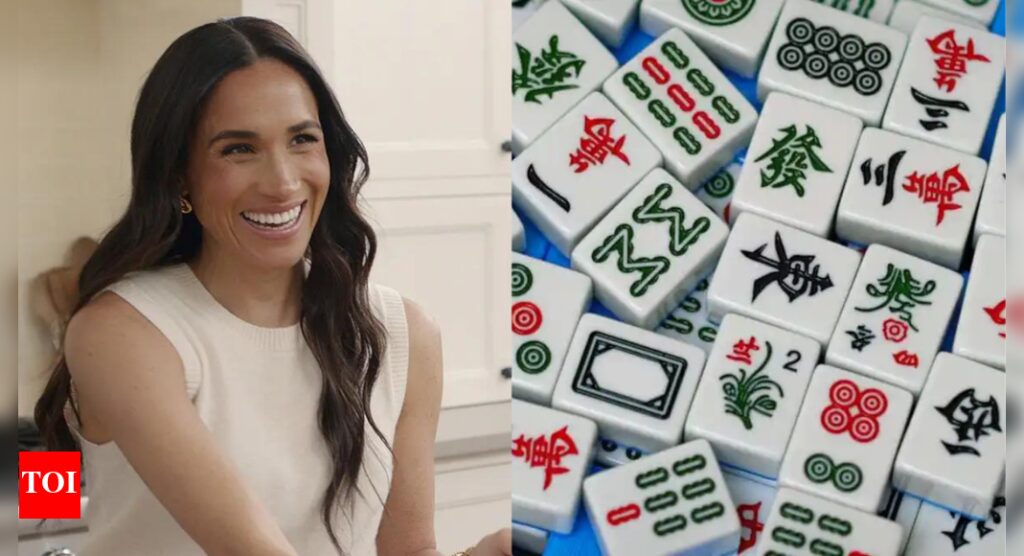What’s the tile game Meghan Markle played on Netflix? A beginner’s guide to mahjong

A centuries-old Chinese game called mahjong is having a modern revival across continents, from luxury cruise ships and trendy hotel lounges to Meghan Markle’s Netflix series.
In the sixth episode of her docuseries With Love, the Duchess of Sussex invites friends for a cosy game night – playing mahjong, reports the Globe and Mail.
The four-person tile-based game, traditionally associated with Chinese culture, is now catching on with new generations across the globe. “The game itself is really so fun,” says Markle. “But what was so great was the idea of learning something new with your friends, together… the mahjong becomes the background of the expansion of friendship. It’s the feeling of community.”
From the Qing dynasty to pop culture
Mahjong dates back to the mid-1800s during the Qing Dynasty in China. Traditionally played with 144 tiles, the game blends skill, strategy and a touch of luck. Players pick and discard tiles to form winning hands, much like the card game rummy.
The game’s expansion across the world has now erupted into a full-blown trend. The World Mahjong Championship was recently held in Mississauga, Ontario – the first time it’s been hosted in North America. Hotels such as the Ace Hotel New York and Thompson Hotel Dallas regularly hold mahjong-themed nights.
Fans with money to spare are buying fancy mahjong sets from Hermès, Louis Vuitton, and Ralph Lauren. Some are even splashing out on luxury tables that shuffle the tiles automatically – costing over $4,500.
Even cruise ships have joined the trend, offering mahjong tournaments and special rooms just for playing the game.
How is mahjong played?
Mahjong is played with 144 tiles. Players begin by shuffling the tiles face down. Everyone rolls dice and the highest roller becomes the dealer. Each player picks 36 tiles and builds a wall—two rows of 18 tiles. The walls are pushed forward, creating a space in the middle for discards. Each player then draws 13 tiles (the dealer starts with 14), and the game begins.
Players take turns drawing one tile and discarding one, always keeping 13 tiles in hand. You can draw a new tile or pick up someone’s discarded one. If a discarded tile helps complete a set (called a meld), you can grab it, announce the set, and show the tiles. To win, a player must have four melds (like three or four matching tiles or a sequence of three in a suit) and one pair (two matching tiles)—making 14 tiles total.
There are five types of tiles: Bamboo, Characters, Dots (these are the three main suits), and special tiles called Honors (Dragons and Winds) and Bonus (Flowers and Seasons). Each suit goes from 1 to 9. Honors and Bonus tiles add extra excitement but aren’t needed to win. Mahjong mixes strategy and memory with a bit of luck—and it’s all about building the right sets before your opponents do.
For many mahjong fans, it’s not just a game but a deeply social experience.
- Connor Wan, a 29-year-old British-Chinese artist, learned mahjong while visiting family in Hong Kong. He enjoyed it so much that he started the
Four Winds Mahjong Club in London, and later brought it to Toronto after moving there in 2024. “Moving countries is hard, especially when you don’t know anyone,” he said. The club became popular quickly, not as a place for gambling, but for making friends and celebrating Asian culture. - Nicole Wong, a writer and audio producer from California, started playing mahjong as a teenager with her grandparents. She later began The Mahjong Project in 2019 to share the game’s cultural stories and organise pop-up game nights. This year, she published a book called Mahjong: House Rules from Across the Asian Diaspora. Nicole says the sound of the tiles is especially powerful. “Mahjong is more than just fun,” she says. “It has a deep history and brings back strong memories.”
- In Toronto, Robyn Feldberg has taught over 250 people how to play mahjong through her courses. She donates all the money—about $50,000 so far—to charities like Save A Child’s Heart. She says the game is especially popular with young mothers who want a fun way to relax and connect with others. “They tell me, ‘We want something that’s just for us,’” she said.






